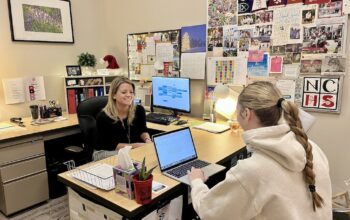
When sophomore Liz Gordon was diagnosed with scoliosis, she learned she would have to alter her daily routines to accommodate her treatment course, and help put an end to her back pains.
Many others, like Liz, have to accommodate to life with scoliosis. According to Boston Brace, the leading provider of pediatric orthotic and prosthetic patient care in the country, one in every 1,000 children between ages 3-5 develops scoliosis, and girls especially are affected, as the condition is more prevalent among females.
Because scoliosis can often be hard to detect, measures have been put in place by the school to ensure that those affected can be diagnosed. “When an infant is born, their spinal integrity must be immediately checked, as they may be at risk of having one of the types of scoliosis, which is a genetic disorder,” school nurse Josie Davies said. “Children may also develop scoliosis as they grow, so spinal checks take place throughout this growth period starting in elementary schools up until 9th grade.”
Sophomore Liz Gordon discovered she had developed scoliosis in January of 2012. “I went to see a back doctor when I began having extreme back pains to the point where I couldn’t sit in class without serious discomfort,” she said. “After an x-ray they confirmed that I developed scoliosis.”
Once diagnosed, many must undergo treatment or take preventative measures to ensure that the integrity of their spine does not further deteriorate. “I underwent treatment for a year, where I had to wear a nighttime brace to bed that would prevent further curving of my spine,” sophomore Page Jones said. “My doctors also suggested that I do special stretches or participate in yoga to further help my back.
Students who have been prescribed braces often face challenges. “When I had to wear my brace from seventh grade to sophomore year, I was really restricted in my clothing choices,” senior Kaitlyn Vollweiler said. “I was often forced to opt for looser clothes, and not being able to wear the clothing I wanted was often quite frustrating.”
Liz also noted how the treatment affects her time management. “The night brace has caused me to lose a lot of sleep, as it is very uncomfortable,” Liz said. “The lack of sleep and the many lengthy appointments I’ve had to attend regarding my scoliosis has ended up negatively influencing my grades.”
Senior Emily Baldwin recognized the further physical effects of scoliosis. “Although my scoliosis isn’t as extreme as others, having scoliosis makes a person more susceptible to develop back injuries,” she said. “I ended up pulling and hyper-extending a muscle in my back, which eventually forced me to quit field hockey. It’s really frustrating to have to sacrifice something I love.”
Other athletes have been similarly affected, as they end up sacrificing things they love or bearing pain as a result of the condition. “As a football player, my diagnosis prevented me from performing certain lifts in the weight room, particularly the ‘dead lift’,” senior Lucian Soro said.
Despite these challenges, most students face their circumstances with optimistic views. “I’ve learned that no matter how uncomfortable I might feel when I have when I have to wear my brace, it’ll all be worth it in the end when I’m healthy,” Kaitlyn said.
“I still love track, despite the pain or back spasms I tend to face while running,” Liz said. “I’m not going to let scoliosis take away from what I love to do, I just need to stay careful and regulate my health.”




A scoliosis diagnosis may limit what kinds of activities a young person can do, but that doesn’t mean that they can’t participate in any activities. A lot depends on the severity of the condition and a doctor can help a patient determine what kind of exercise is right for them.